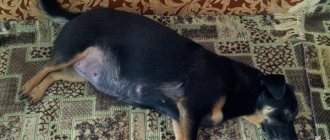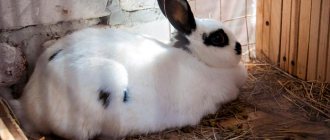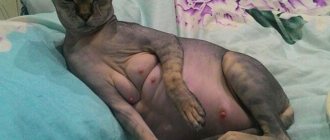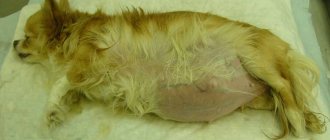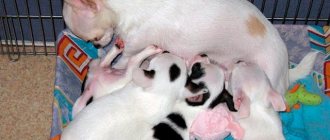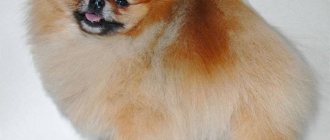If you do not plan to sterilize your female pug, but want to breed these cute dogs, you definitely need to know how long pregnant pugs walk. This information will help you prepare for the birth of your offspring. This will also be useful for owners of male dogs - usually they are entitled to child support for their participation in mating.
Next, we will look at how pugs bear offspring, how long pregnancy lasts in pugs, and how the condition of a pregnant dog changes when it is expecting puppies. Let's tell you how many puppies a pug gives birth to.
Features of pregnancy in pugs
Several important features of pregnancy in a pug dog:
- The first heat in pugs begins between 6-12 months. However, experienced breeders do not recommend breeding a pet until it is two years old. Otherwise, the animal will experience serious complications during the birth of the pug pups.
- The normal gestation period for a pug is 57 to 67 days. If it lasts longer in your pet, you need to urgently take him to a veterinarian.
- On average, a female gives birth to 3-5 puppies at a time. But 1 or 7-9 pugs at a time is also considered the norm.
- Sometimes a dog experiences a phenomenon called a false pregnancy.
- You should not breed pugs more than once a year. The female needs time for physical and emotional recovery.
- To find out if the female is pregnant, you need to visit a veterinarian. This cannot be determined using a test for humans because dogs do not have the hCG hormone.
False and frozen pregnancy
From time to time, every bitch shows (to a greater or lesser extent) signs of false pregnancy. According to some dog handlers, pseudo-pregnancy is a kind of primitive technique that allowed the females of one dog pack to feed other people’s puppies.
An imaginary pregnancy is not always accompanied by vivid symptoms (nervousness, loss of appetite, nest building, lactation and “birth”): often these signs are almost invisible. Typically, false pregnancy occurs once after each estrus, but relapses also occur.
Important! Sometimes false pregnancy goes away on its own, but more often the pug requires treatment - hormonal injections with estrogens, progestogen, androgens and prolactin antagonists, and in extreme cases, sterilization.
It is a rare canine body that tolerates hormonal drugs without consequences. That is why owners are increasingly willing to use homeopathic medicines, the most popular of which is Ovariovit. It regulates the functioning of the pituitary gland, normalizes hormonal levels and calms the nervous system.
To treat pseudopregnancy, Ovariovit is used in tablets (10-14 days) or in ampoules . The solution is injected under the skin once a day (5-10 days). Treatment is continued (1-2 injections per week) if necessary. For 10 kg of weight take 1 ml of the drug.
In addition, Ovariovit, used before mating, stimulates ovulation, increasing the chances of fertilization and leading to an increase in offspring.
A frozen pregnancy, which occurs due to hormonal abnormalities, infections or pathologies of the embryos, is determined using ultrasound, which shows whether the embryos remain alive.
Pregnancy is preserved if any are detected (they leave the uterus during childbirth along with the dead). Otherwise, a miscarriage is expected. At the end of labor, they check to see if there are any fragments of dead embryos left. Contractions stimulate the decomposition of the fetuses so that they come out of the uterus, further subjecting the pug to (not always) sterilization.
Return to content
How can you tell if a female is pregnant?
Vivid signs of developing pregnancy in a female are observed in the second half of pregnancy. These include symptoms such as:
- sharp and frequent fluctuations in appetite. The dog either refuses to eat or begins to really want to eat and constantly ask for more;
- the female begins to sleep more, becomes less active and inquisitive;
- the animal’s mammary glands swell and acquire a rich pink color;
- Colorless or whitish mucus is occasionally discharged from the external genitalia;
- Some pugs develop toxicosis.
To make sure that the dog is pregnant and is about to give birth to puppies, you need to visit a veterinary clinic. This will establish the fact of pregnancy and exclude false pregnancy.
Duration of wearing
On average, dogs carry puppies for 60 days, about 2 months.
Larger breeds bear cubs for 62 - 63 days, small dogs for about 58 days.
By the 25th - 30th day of a dog's pregnancy, the skin in the area of the nipples turns pink and they swell.
- after 33 days there is an active increase in the abdomen;
- closer to the day of birth, the stomach drops;
- active greenish or yellowish discharge is observed from the loop;
If this is your pet’s first pregnancy, then perhaps she will begin to produce milk a few days before giving birth; if she is already an experienced mother, then nipple discharge may be observed as early as 13 weeks.
How to care for a pregnant dog?
A pet expecting offspring requires special care. And first of all, this applies to changes in diet, adherence to activity and rest. If improperly cared for, the female often develops severe swelling of the mammary glands and hind legs.
Feeding a pregnant pug
During gestation, the female undergoes a global restructuring of her body. Nutrition and vitamins in this case directly affect the course of pregnancy and the development of embryos.
If you feed your pet natural products, you can continue to give her her usual diet, the main thing is that meat and meat by-products make up at least 2/3 of the total diet.
If your pet eats ready-made dry food, you need to slowly introduce natural products into the regular diet. And the main one is raw meat. It could be beef, turkey or not too fatty lamb. In addition to meat, the female should be given raw egg yolk, cheese, goat's milk and natural yogurt 2-3 times a week. Milk protein normalizes the growth of fetal tissue and maintains the health of the expectant mother.
Another important addition is vitamins and microelements. The main supplements for pugs during pregnancy include:
- Fatty acid. This is the omega-3 found in fish oil. It is better to give the female omega-3 in capsule form.
- Folic acid. This is a B vitamin that prevents developmental defects in the fetus and promotes its proper formation.
- Calcium. This mineral is directly involved in the formation of skeletal bones and teeth. Calcium should be added to the diet taking into account the needs of both the female and the fetus. However, an excess of this microelement is harmful: because of this, the production of hormones is suppressed.
During pregnancy, the pug should be fed not twice, but three times a day.
Physical activity and rest
Low mobility of the dog will lead to severe swelling and weakening of the muscles. Therefore, a female puppy should be walked daily and for at least two hours. The sun and fresh air will have a positive effect on the animal’s well-being.
The main thing is not to allow the girl to lie on wet grass or on a cold surface. You can’t run up the stairs or jump off.
Vaccination during pregnancy of a dog
The dog requires one vaccination per year and preliminary deworming. If the time of vaccination coincides with the onset of estrus, it is necessary to vaccinate a little earlier. And then the born offspring will already have antibodies passed on from the mother.
It is impossible to deworm a pregnant female; in extreme cases, this can be done before the third week of gestation. The opposite threatens miscarriage. Therefore, when planning a mating, you need to rid your pet of worms in advance.
Neutering pugs: what you need to know
Sterilization is the term for disrupting reproductive functions through surgery. Studies conducted in this direction have revealed that sterilized pugs have an increased life expectancy of 2 years. The animal becomes more obedient and calm.
Important! Sterilization can prevent the development of cysts and neoplasms in the organs of the reproductive system.
This procedure is performed through an incision in the abdomen, below or on the side. In this case, the ovaries are removed along with or without the uterus. The first option is preferable, because the uterus also produces hormones, and this can cause inflammation.
It is not recommended to perform the operation before 10 months, as this may lead to developmental delays.
For females, an important factor is having already experienced estrus (at least one).
The operation is performed under general anesthesia, so you must stop giving food 8 hours before the operation. Excessive feeding is also not recommended for the day after it. It is necessary to ensure that the dog does not harm itself.
The seams must be processed and inspected within two weeks. Usually removal occurs on the 12th day after the intervention.
In order for your pet to live long and be healthy, you will have to constantly care for it. And getting a dog to produce offspring means acquiring great responsibility. By following all the rules for mating pugs and choosing the right pair, you can achieve the birth of beautiful and well-born puppies.
The first signs of labor in a pug
Harbingers of the onset of labor are the breaking of water and gradually becoming more frequent contractions. You can find out that a pug is giving birth by a number of other signs. This includes a change in behavior, drooping of the abdomen and a decrease in the animal’s temperature to 37 degrees Celsius.
Pug contractions
The duration of prenatal contractions ranges from 12 to 24 hours, after which pushing begins. Typically, in dogs giving birth for the first time, they last more than 20 hours. It is imperative to note the time between contractions to understand whether the female is ready to give birth. If the contractions stop on their own, or the intervals between them are very long, this indicates a false birth.
There should be no more than an hour between contractions and pushing. The opposite indicates that the pug is stuck in the birth canal. In this case, the dog cannot give birth on its own and urgent assistance from a veterinarian is required.
Pug behavior before giving birth
Before giving birth, the female's behavior changes noticeably. The animal becomes restless, begins to rush around the house and cannot find a place for itself. The dog often licks itself and whines. In addition, the pet completely refuses to eat, becomes apathetic and lethargic.
Pug pregnancy calendar in detail by day and week
- 1 week: 0-7 days. If the mating is successful, fertilization of the egg occurs on the fourth day after mating. All this time, sperm travel to their target through the fallopian tubes. The dog shows no signs of pregnancy. Her behavior doesn't change. There is no need to change your diet or walking schedule. Some pugs may experience mild nausea on day 7 and light pink discharge on the vulva.
- Week 2: 7-14 days. The fertilized cell divides, tiny embryos appear, which enter the uterine cavity, forming the placenta (baby place). The dog's behavior does not change much, but he may look more tired. There may be slight nausea in the morning.
- Week 3: 14-21 days. Embryos are implanted into the uterus and grow up to 1 cm. The embryos develop the main organs (head, central nervous system, spine, heart). The dog's diet and daily routine do not need to be radically changed. The dog experiences mood swings and there may be a slight decrease in appetite. Her hair is thinning on her stomach and around her mammary glands. During this period, vaccinations and antiparasitic treatment are prohibited.
- Week 4: 21-28 days. The embryo grows up to 1.5 cm. They can be felt by palpating the abdomen. The embryos develop the outlines of a muzzle, eyes, teeth, ears, liver, limbs are formed, and the spine is strengthened. A clear discharge appears from the bitch's vulva, the nipples increase in size, and the belly swells. The dog's appetite is growing. The diet must be changed by increasing the number of feedings and reducing portions. The dog is protected from stress and increased activity.
- Week 5: 28-35 days. The amount of amniotic fluid increases; puppies cannot be felt by palpation. The embryos develop sexual characteristics, whiskers, fingers and claws. The dog's portion needs to be increased and the bitch switched to food for pregnant and lactating women. All external signs of pregnancy become clearly visible. The nipples swell and darken, and the dog's weight increases. The pug behaves less active and has frequent mood swings. The dog gets tired quickly, avoids walks, and lies down more.
- Week 6: 35-42 days. Puppies continue to grow and change, their skin pigmentation appears, external features appear, and almost all internal organs are formed. Dogs are additionally given vitamin and mineral complexes for pregnant bitches. You can begin to prepare a place for the birth of pugs at home and gradually accustom the expectant mother to it.
- Week 7: 42-49 days. Puppies have all their organs formed, they grow and develop. They can easily be felt under the mother's skin. But the exact number is not determined; the owners learn how many puppies a pug gives birth to only after they are born. The dog is losing hair in the belly area. The mammary glands swell greatly, their color becomes brighter.
- Week 8: 49-56 days. The size of the embryos reaches 15 cm. They are fully formed. Labor can begin at any time at the end of this week - we need to prevent this. Puppies born before day 57 are not viable! During this period, it is important to pay a lot of attention to the pregnant bitch, protect her peace, and prevent overwork.
- Week 9: 56-64 days. The pug's pregnancy is coming to an end. Waiting period for childbirth. The puppies' movements are clearly noticeable. Everything in the house should be ready for the arrival of babies. The dog must know its place to give birth. The mother's appetite may decrease. The dog is worried, hides in secluded places, refuses to eat. During this period, the pug’s body temperature is measured several times a day; 8-24 hours before giving birth, it drops by 1-1.5 degrees. The discharge of amniotic fluid is a clear harbinger of labor.
So, we looked in detail at how a pug’s pregnancy progresses day by day and week by week. We hope this information will help you and your dog properly during this difficult and important period.
Preparing a pug for birth
To fully prepare for the upcoming birth of a pug, you will need to take care of several things:
- The first and one of the most important is the construction of a house for the expectant mother and her pugs. You can use a regular cardboard box. To do this, you need to cut an inlet hole on it at a height of about 12-14 centimeters, which will close like a door. Inside the house you will need to cover the bottom. Thick foam rubber (about 5 centimeters), a warm blanket and light cotton fabric are suitable for this. It is also necessary to make a removable roof for the house (for example, lay a sheet) so that you can watch the pug and her kids.
- Another box that will be needed is a temporary bed for newborn pugs (a kind of incubator). You need to put a heating pad in it, because hypothermia is deadly for them.
- The room where the birth will take place must be warm, without drafts.
- It is better to choose a low table for the immediate birth place. It is necessary to take care of the fences so that the giving birth dog does not fall from it.
Vaccination
that pug girls be vaccinated in advance, before mating. But sometimes mating happens unplanned, and vaccination needs to be done. What to do?
According to the instructions of the famous French manufacturer about the complex vaccine, this procedure is allowed in the first third of pregnancy, i.e. up to 20 days. The instructions also indicate that this procedure is contraindicated for sick and weak animals.
If the expectant mother experiences toxicosis, postpone the vaccination until later. Caring owners prefer not to risk the health of their pet and future children - they postpone vaccination until a later time. When babies turn 2 months old, the whole family is taken for vaccination.
What is needed to give birth to a dog?
To give birth at home yourself, you will need to prepare a whole list of things:
- you need to prepare several light, soft cotton napkins or sheets;
- you need to prepare gauze swabs (but not cotton swabs). They will be needed to wet the mouths and noses of newborn pugs;
- prepare two baths for water. One for cold, one for hot. This is in case there is a need to carry out resuscitation measures;
- put nearby sterile scissors, cotton wool, a jar of brilliant green and disinfectants (for example, Chlorhexidine), an ampoule of No-shpa for pain relief. It is recommended to have Oxytocin to prevent large blood loss;
- prepare cotton threads for ligating the cut umbilical cord;
- It wouldn’t hurt to have Vaseline or Syntomycin on hand if your dog needs help with a massage.
How to give birth?
Accepting the onset of labor is a responsible task, but there is no need to panic or worry excessively. The owner's excitement is transmitted to the dog. How should childbirth be delivered? First of all, you need to understand that not every pug will need help in giving birth. While everything is going well, the owner must carefully monitor the course of events and be ready to instantly come to the dog’s aid.
Whether intervention will be needed during labor depends on the position in which the puppy is born:
- If the baby comes out with his butt forward and his back to the mother’s back, this is the most favorable option. If the puppy walks butt forward, but is facing the other way, you can help him: to do this, lightly grab the baby by the fur and pull. But under no circumstances should you pull the hind legs or tail.
- If the puppy walks sideways or with its belly up, you need to carefully bend it and help it out in accordance with its position.
- If the puppy comes out head first, you need to free his muzzle from the diapers and try to grab him by the scruff of the neck. Holding him this way, straighten his paws with your fingers and slightly pull him up.
- If a pug, walking butt forward, gets stuck halfway, there are two ways to help. The first is to take him by the scruff of the neck and begin to swing him slightly from side to side. After these actions, the shoulders should come out one after another. The second method is to insert a finger (parallel to the puppy) and straighten its front legs. Next, you need to carefully and slowly pull it. It is important not to bend the new puppy into an unnatural position.
Sometimes the female cannot bite off the umbilical cord on her own. In this case, the owner will need to take sterile scissors and thread. You need to cut the umbilical cord at a level of three to four centimeters from the puppy’s tummy, then tie it with a thread at the end.
As soon as the next pug goes, move the first one to a warm box prepared in advance.
After the end of labor, the female will want to eat. This is an indicator of a successfully completed birth.
Preparing a nest for babies
A week before the birth, the owner must take care of organizing the place where the born puppies will be kept. This should be a comfortable “corner” in all respects. Under no circumstances should you sit in a walkway or where there are drafts. A place in the corner of the room, where too much sunlight does not fall, is suitable.
In specialized stores you can purchase a ready-made maternity room - a box. But you can prepare it yourself from thick plywood. The height of the sides is approximately 20-25 cm, dimensions 80x80 cm. More accurate numbers will tell you the size of your dog. One side of the box should be hinged for easy cleaning. The entire allocated area must be divided in half by a partition with a small recess. In one half the puppies and mother will rest, and in the other they will feed. Growing kids will not be able to get out of such a “nest” on their own and will not crawl all over the room.
An important point is that you need to make a side on the inside of the walls of the box. A wooden strip measuring 4x4 cm will do. Secure it around the entire perimeter. Then the dog will not be able to lean closely against the walls and will not accidentally crush the puppy who is between it and the wall of the box.
You can use felt as a bedding for the bed, or a thick towel will do. In order for the dog to accept this “nest,” introduce the bitch to it about a week before giving birth, temporarily placing old bedding there that retains her scent. In the second half of the “box” place cups of water and food.
How do pugs give birth?
Contractions are often, but not always, accompanied by heavy breathing and chills. In addition, the dog will try to dig.
The beginning of pushing is accompanied by tension in the abdominal muscles. It becomes hard. Gradually the attempts intensify, subsequently passing in a series in a row. At this moment, the animal must be in the place for birth (on a table, sofa, in a box, etc.)
When pushing, the dog either lies or sits in a position characteristic of relieving itself.
The stronger the attempts, the more the pet changes. She will begin to throw her head back and move her tail to the side.
What complications may occur during childbirth?
A dangerous complication that you may encounter is the pug getting stuck in the birth canal. In this case, the dog will need urgent help from the owner.
To make sure that the baby is stuck, you need to monitor the time interval of birth. Normally, puppies are born twenty minutes after the previous one. If it is clear that the animal is suffering, it is necessary to help the fetus come out.
In addition to getting your puppy stuck, other dangerous conditions during labor include:
- absence of labor, although the due date has already approached;
- painful attempts that do not lead to birth;
- stillbirth;
- retention of the placenta, observed after the birth of all puppies.
Some are wearing a shirt and some are naked
When the bitch begins to push, this will be visible by the contraction of her abdominal muscles. During childbirth, she can sit, lie down, or take other positions that are comfortable for her. Do not interfere with the dog's chosen position. Since the process can last several hours, it is better for this to happen at an elevated location. Use a table or chair covered with oilcloth.
You should know that every newborn puppy is enclosed in two membranes where amniotic fluid is present. They can come off as the puppy passes through the birth canal if the first one ruptures. Both can also tear, and then the puppy will “gobble up”. In this case, you need to gently shake him upside down so that he can breathe. A puppy can be born “in a shirt” when both membranes remain intact. Then you yourself must free it from them by tearing it with your finger.
A pug bitch, due to her special figure, cannot always wriggle out and bite the umbilical cord of the puppy who gave birth. You must help her by cutting the umbilical cord with sterile scissors at a distance of 2 cm from the baby’s tummy and tying it with thread. After a couple of days, the stump will dry out and fall off.
How many puppies does a pug give birth to?
The birth of small puppies is a great joy and relief for the female. One pug litter most often contains three to five babies. However, the norm is a number from one to nine.
For the first time
It is impossible to predict how many puppies there will be in a pug's first litter. An ultrasound scan of the dog will provide information about their health and proper development.
On subsequent occasions
The number of puppies in the litter does not depend on how many times the bitch gave birth. From one to nine babies are born at a time.
Possible difficulties
After watching your pet go through all the stages of pregnancy, watching her give birth is the ultimate reward.
Most of the time her body does exactly what it's supposed to do and her puppies will come out without a problem.
However, sometimes the process does not go as nature intended. When a puppy becomes stuck in the birth canal, prompt action on your part can save the life of the puppy and the mother.
How to help? Before you intervene, make sure there is actually a problem and the animal needs help. A dog's labor usually lasts from three to 12 hours, and occurs in three stages. Puppies are born during the second stage and appear 20 minutes apart from each other.
Before you intervene, see how long the pushing lasts. The animal can rest for up to two hours between the birth of puppies. When each puppy is born, you need to check that it is breathing and help it if necessary.
Caring for puppies after birth
When born, tiny pugs do not yet see or hear, and they have no teeth. Babies have two instincts: to suck milk and crawl to the warmth of their mother. But it happens that puppies cannot perform these actions on their own. And then we need to help them. Care that needs to be organized for puppies:
- The box in which they will be placed should be warm and spacious. This is necessary for free movement and ease of feeding with milk. You also need to remove folds on the soft surface so that the puppies do not get entangled in them.
- Use a heating lamp for heating. Place a thermometer in the box to monitor the temperature. Watch the kids themselves: their behavior will let you know when they feel uncomfortable. If puppies sleep tightly huddled together, this means they are cold.
- After the babies are born, you need to keep a table of their growth and condition. Children's or kitchen scales are suitable for weighing. It is necessary to note the body weight of each baby in order to track the dynamics.
